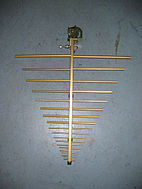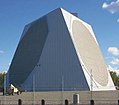Directional antenna

Adirectional antennaorbeam antennais anantennawhich radiates or receives greater radio wave power in specific directions. Directional antennas can radiateradio wavesin beams, when greater concentration of radiation in a certain direction is desired, or in receiving antennas receive radio waves from one specific direction only. This can increase the power transmitted to receivers in that direction, or reduceinterferencefrom unwanted sources. This contrasts withomnidirectional antennassuch asdipole antennaswhich radiate radio waves over a wide angle, or receive from a wide angle.
The extent to which an antenna's angular distribution of radiated power, itsradiation pattern,is concentrated in one direction is measured by a parameter calledantenna gain.Ahigh-gain antenna(HGA) is a directional antenna with a focused, narrowbeam width,permitting more precise targeting of the radio signals.[1]Most commonly referred to duringspace missions,[2]these antennas are also in use all overEarth,most successfully in flat, open areas where there are no mountains to disrupt radiowaves.[citation needed]
In contrast, alow-gain antenna(LGA) is anomnidirectional antenna,with a broad radiowave beam width, that allows the signal to propagate reasonably well even in mountainous regions and is thus more reliable regardless of terrain. Low-gain antennas are often used inspacecraftas a backup to thehigh-gain antenna,which transmits a much narrower beam and is therefore susceptible to loss of signal.[3]
All practical antennas are at least somewhat directional, although usually only the direction in the plane parallel to the earth is considered, and practical antennas can easily be omnidirectional in one plane. The most common directional antenna types are[citation needed]
- theYagi-Uda antenna,
- thelog-periodic antenna,and
- thecorner reflector antenna.
These antenna types, or combinations of several single-frequency versions of one type or (rarely) a combination of two different types, are frequently sold commercially as residentialTV antennas.Cellular repeatersoften make use of external directional antennas to give a far greater signal than can be obtained on a standardcell phone.Satellite televisionreceivers usually useparabolic antennas.For long and mediumwavelengthfrequencies,tower arraysare used in most cases as directional antennas.
Principle of operation[edit]
When transmitting, ahigh-gain antennaallows more of the transmitted power to be sent in the direction of the receiver, increasing the received signal strength. When receiving, a high gain antenna captures more of the signal, again increasing signal strength. Due toreciprocity,these two effects are equal—an antenna that makes a transmitted signal 100 times stronger (compared to anisotropic radiator) will also capture 100 times as much energy as the isotropic antenna when used as a receiving antenna. As a consequence of their directivity, directional antennas also send less (and receive less) signal from directions other than the main beam. This property may avoid interference from other out-of-beam transmitters, and always reduces antenna noise. (Noise comes from every direction, but a desired signal will only come from one approximate direction, so the narrower the antenna's beam, the better the crucialsignal-to-noise ratio.)
There are many ways to make a high-gain antenna; the most common areparabolic antennas,helical antennas,Yagi-Uda antennas,andphased arraysof smaller antennas of any kind.Horn antennascan also be constructed with high gain, but are less commonly seen. Still other configurations are possible—theArecibo Observatoryused a combination of aline feedwith an enormous spherical reflector (as opposed to a more usual parabolic reflector), to achieve extremely high gains at specific frequencies.
Antenna gain[edit]
Antenna gainis often quoted with respect to a hypothetical antenna that radiates equally in all directions, anisotropic radiator.This gain, when measured indecibels,is called dBi. Conservation of energy dictates that high gain antennas must have narrow beams.[4]For example, if a high gain antenna makes a 1Watttransmitter look like a 100 Watt transmitter, then the beam can cover at most1/100of the sky (otherwise the total amount of energy radiated in all directions would sum to more than the transmitter power, which is not possible). In turn this implies that high-gain antennas must be physically large, since according to thediffraction limit,the narrower the beam desired, the larger the antenna must be (measured in wavelengths).
Antenna gain can also be measured in dBd, which is gain indecibelscompared to the maximum intensity direction of a half wave dipole. In the case ofYagi-typeaerials this more or less equates to the gain one would expect from the aerial under test minus all its directors and reflector. It is important not to confuse dBiand dBd;the two differ by 2.15 dB, with the dBi figure being higher, since a dipole has 2.15 dB of gain with respect to an isotropic antenna.
Gain is also dependent on the number of elements and the tuning of those elements. Antennas can be tuned to be resonant over a wider spread of frequencies but, all other things being equal, this will mean the gain of the aerial is lower than one tuned for a single frequency or a group of frequencies. For example, in the case of wideband TV antennas the fall off in gain is particularly large at the bottom of the TV transmitting band. In the UK this bottom third of the TV band is known as group A.[5]
Other factors may also affect gain such as aperture (the area the antenna collects signal from, almost entirely related to the size of the antenna but for small antennas can be increased by adding aferrite rod), and efficiency (again, affected by size, but also resistivity of the materials used and impedance matching). These factors are easy to improve without adjusting other features of the antennas or coincidentally improved by the same factors that increase directivity, and so are typically not emphasized.
Applications[edit]
High gain antennas are typically the largest component of deep space probes, and the highest gain radio antennas are physically enormous structures, such as theArecibo Observatory.TheDeep Space Networkuses 35 m dishes at about 1 cm wavelengths. This combination gives the antenna gain of about 100,000,000 (or 80 dB, as normally measured), making the transmitter appear about 100 million times stronger, and a receiver about 100 million times more sensitive,provided the target is within the beam.This beam can cover at most one hundred millionth (10−8) of the sky, so very accurate pointing is required.
Use of high gain andmillimeter-wavecommunication inWPANgaining increases the probability of concurrent scheduling of non‐interfering transmissions in a localized area, which results in an immense increase in network throughput. However, the optimum scheduling of concurrent transmission is anNP-Hardproblem.[6]
Gallery[edit]
-
An early example (1922) of a directional AM radio transmitter using along wire antenna,built forWOR,then in Newark, New Jersey and targeting both New York City and Philadelphia in addition to Newark.
-
Karl Janskyand his rotating directional radio antenna (1932) inHolmdel, New Jersey,which was the world's first radio telescope, discovering radio emissions from theMilky Way.
-
Grote Reber's homemade antenna inWheaton, Illinois(1937), world's second radio telescope andfirst parabolic radio telescope
-
Holmdel Horn AntennainHolmdel, New Jersey(1960s). Built to support theEcho satellitecommunication program,[7]it was later used in experiments that revealed theCosmic microwave backgroundpermeating the universe.[8]
-
Parabolic antenna– the 70 m antenna atGoldstone Deep Space Communications Complexin the Mojave Desert,California
-
Voyager 2spacecraft. The HGA (a parabolic antenna) is the large bowl-shaped object.
-
A giantphased-arrayradar in Alaska
-
AYagi-Uda antenna.From left to right, the elements mounted on the boom are called the reflector, driven element, and director. The reflector is easily identified as being a bit longer (5% or more) than all the other elements, and the director(s) a bit shorter (5% or more).
See also[edit]
References[edit]
- ^Zainah Md Zain; Hamzah Ahmad; Dwi Pebrianti; Mahfuzah Mustafa; Nor Rul Hasma Abdullah; Rosdiyana Samad; Maziyah Mat Noh (2020).Proceedings of the 11th National Technical Seminar on Unmanned System Technology 2019: NUSYS'19.Springer Nature. p. 535.ISBN978-981-15-5281-6.Extract of page 535
- ^Joseph A. Angelo (2014).Encyclopedia of Space and Astronomy.Infobase Publishing. p. 364.ISBN978-1-4381-1018-9.Extract of page 364
- ^"Low-gain antenna".Oxford Reference (oxfordreference ).
- ^"Low gain aerial acceptance angle".Row ridgeTX.aerialsandtv.
- ^For comparison of groups of aerials to awidebandaerial of the same size / model,see"Gain graph".aerialsandtv.
- ^Bilal, Muhammad; et al. (2014). "Time-slotted scheduling schemes for multi-hop concurrent transmission in WPANs with directional antennas".ETRI Journal.36(3): 374–384.arXiv:1801.06018.doi:10.4218/etrij.14.0113.0703.S2CID2285688.
- ^Crawford, A.B.; Hogg, D.C.; Hunt, L.E. (July 1961). "ProjectEcho:A horn-reflector antenna for space communication ".The Bell System Technical Journal:1095–1099.doi:10.1002/j.1538-7305.1961.tb01639.x.
- ^"Horn antenna".Astronomy and astrophysics. History. U.S.National Park Service.2001-11-05. Archived fromthe originalon 2008-05-12.Retrieved2008-05-23.
External links[edit]
- "What are high and low gain?".qrg.northwestern.edu.Communications. Evanston, IL:Northwestern University.






![Holmdel Horn Antenna in Holmdel, New Jersey (1960s). Built to support the Echo satellite communication program,[7] it was later used in experiments that revealed the Cosmic microwave background permeating the universe.[8]](https://upload.wikimedia.org/wikipedia/commons/thumb/f/f7/Horn_Antenna-in_Holmdel%2C_New_Jersey_-_restoration1.jpg/120px-Horn_Antenna-in_Holmdel%2C_New_Jersey_-_restoration1.jpg)



